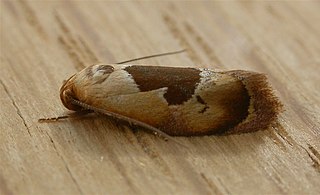| Plectophila electella | |
|---|---|
| Scientific classification | |
| Kingdom: | Animalia |
| Phylum: | Arthropoda |
| Class: | Insecta |
| Order: | Lepidoptera |
| Family: | Xyloryctidae |
| Genus: | Plectophila |
| Species: | P. electella |
| Binomial name | |
| Plectophila electella (Walker, 1864) | |
| Synonyms | |
| |
Plectophila electella is a moth in the family Xyloryctidae. It was described by Francis Walker in 1864. It is found in Australia, [1] where it has been recorded from New South Wales, Queensland and South Australia.

Moths comprise a group of insects related to butterflies, belonging to the order Lepidoptera. Most lepidopterans are moths, and there are thought to be approximately 160,000 species of moth, many of which have yet to be described. Most species of moth are nocturnal, but there are also crepuscular and diurnal species.

Xyloryctidae is a family of moths contained within the superfamily Gelechioidea described by Edward Meyrick in 1890. Most genera are found in the Indo-Australian region. While many of these moths are tiny, some members of the family grow to a wingspan of up to 66 mm, making them giants among the micromoths.

Francis Walker was an English entomologist. He was one of the most prolific authors in entomology, and stirred controversy during his later life as his publications resulted in a huge number of junior synonyms.
The wingspan is 15–16 mm. The forewings are silvery white with bright deep ochreous-brown markings, partially margined with light ochreous-yellowish scales and with a straight narrow fascia from the base of the costa to one-fourth of the inner margin. There is a streak from the upper extremity of this beneath the costa, bent up to the costa before the middle, and continued along the costa to four-fifths. A moderate irregular fascia from this streak before it reaches the costa to the inner margin at three-fifths where it runs into a thick streak, attenuated at the extremities, along the inner margin from before the middle to the anal angle. There is a moderate fascia from the costa at three-fifths towards the anal angle but not quite reaching it, connected with the preceding fascia by a slender line in the middle. A subapical spot, including a white dot on the hindmargin, is sometimes connected beneath with the lower extremity of the preceding fascia. The hindwings are grey, slightly ochreous tinged. [2]

The wingspan of a bird or an airplane is the distance from one wingtip to the other wingtip. For example, the Boeing 777-200 has a wingspan of 60.93 metres, and a wandering albatross caught in 1965 had a wingspan of 3.63 metres, the official record for a living bird. The term wingspan, more technically extent, is also used for other winged animals such as pterosaurs, bats, insects, etc., and other fixed-wing aircraft such as ornithopters. In humans, the term wingspan also refers to the arm span, which is distance between the length from one end of an individual's arms to the other when raised parallel to the ground at shoulder height at a 90º angle. Former professional basketball player Manute Bol stands at 7 ft 7 in (2.31 m) and owns one of the largest wingspans at 8 ft 6 in (2.59 m).




